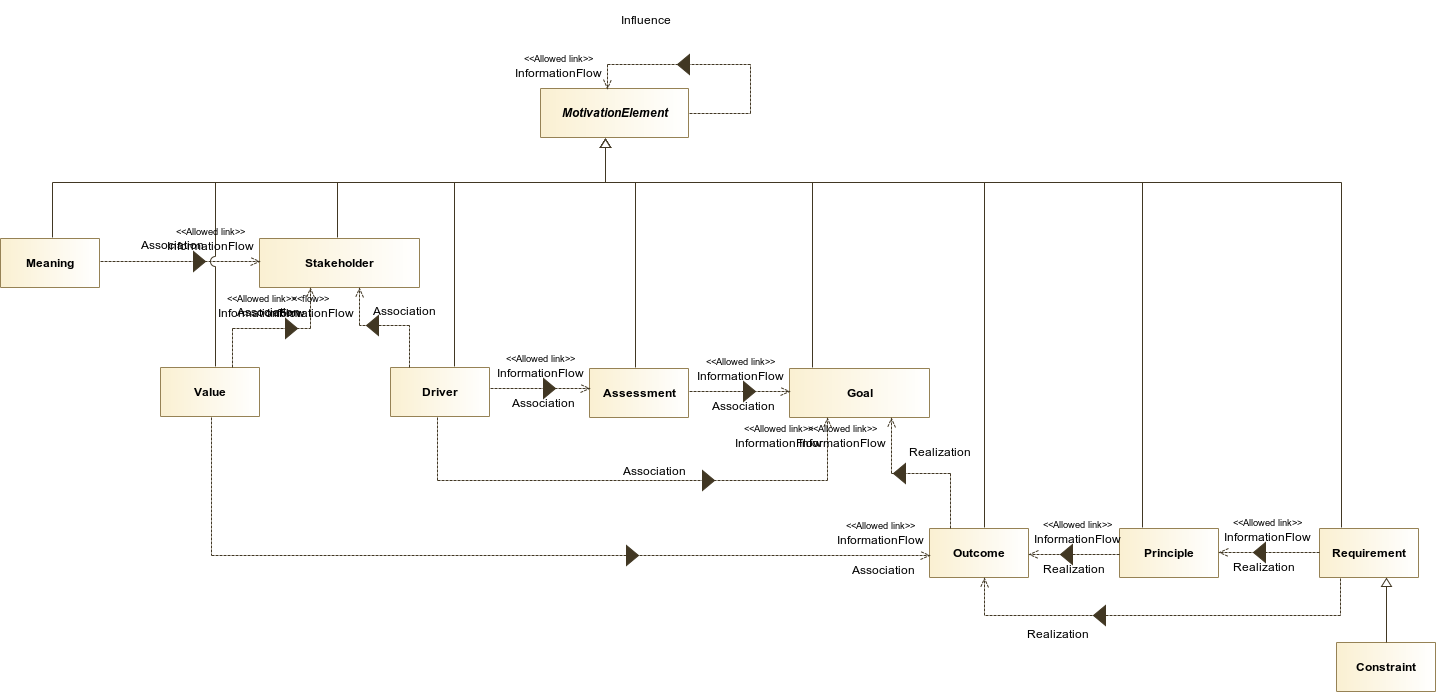
ArchiMate Metamodel
Motivation elements are used to model the motivations, or reasons, that guide the design or change of an Enterprise Architecture.
Stakeholder, Driver, and Assessment
It is essential to understand the factors, often referred to as drivers, which influence other motivation elements. They can originate from either inside or outside the enterprise. Internal drivers, also called concerns, are associated with stakeholders, which can be some individual human being or some group of human beings, such as a project team, enterprise, or society.
Examples of such internal drivers are customer satisfaction, compliance to legislation, or profitability. It is common for enterprises to undertake an assessment of these drivers; e.g., using a SWOT analysis, in order to respond in the best way.
Goal, Outcome, Principle, Requirement, and Constraint
The motivation of an organization or individual to achieve certain results is represented by goals, principles, requirements, and constraints.
Goals represent that a stakeholder wants to realize a certain outcome; e.g., “Increase customer satisfaction by 10%”.
The end results realized by capabilities that realize these goals are outcomes.
Principles and requirements represent desired properties of solutions – or means – to realize the goals. Principles are normative guidelines that guide the design of all possible solutions in a given context. For example, the principle “Data should be stored only once” represents a means to achieve the goal of “Data consistency” and applies to all possible designs of the organization’s architecture.
Requirements represent formal statements of need, expressed by stakeholders, which must be met by the architecture or solutions. For example, the requirement “Use a single CRM system” conforms to the aforementioned principle by applying it to the current organization’s architecture in the context of the management of customer data.
Meaning and Value
Different stakeholders may attach a different value to outcomes, since they may have different interests. Similarly, they may give their own meaning or interpretation to core elements of the architecture.


Class | Summary |
|---|---|
An assessment represents the result of an analysis of the state of affairs of the enterprise with respect to some driver. | |
A constraint represents a factor that prevents or obstructs the realization of goals. | |
A driver represents an external or internal condition that motivates an organization to define its goals and implement the changes necessary to achieve them. | |
A goal represents a high-level statement of intent, direction, or desired end state for an
organization and its stakeholders. | |
Meaning represents the knowledge or expertise present in, or the interpretation given to, a core element in a particular context. | |
An outcome represents an end result that has been achieved. | |
A principle represents a qualitative statement of intent that should be met by the architecture. | |
A requirement represents a statement of need that must be met by the architecture. | |
A stakeholder is the role of an individual, team, or organization (or classes thereof) that represents their interests in the outcome of the architecture. | |
Value represents the relative worth, utility, or importance of a core element or an outcome. |